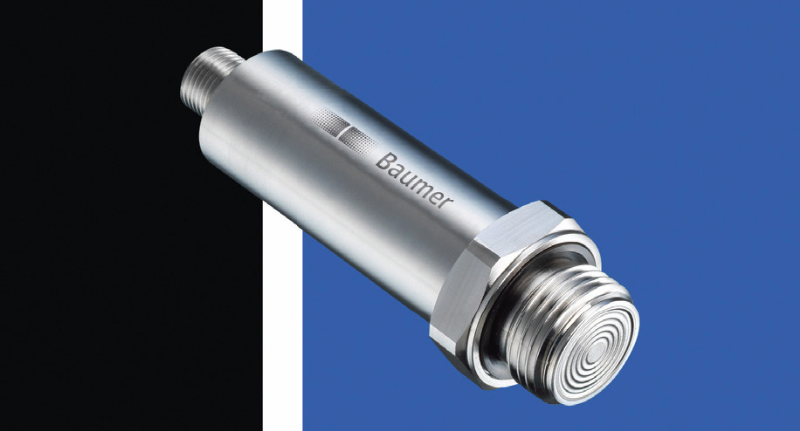 Daniel Hunold, product manager at Baumer, outlines the benefits of the company’s PBMH pressure transmitters, showing how their hygienic design, ATEX compliance and temperature compensation mean they are particularly suited to applications in the food and pharmaceutical industries
Daniel Hunold, product manager at Baumer, outlines the benefits of the company’s PBMH pressure transmitters, showing how their hygienic design, ATEX compliance and temperature compensation mean they are particularly suited to applications in the food and pharmaceutical industries
Measuring instruments for the food and pharmaceutical industries and for medical engineering not only need to comply with hygienic design rules, they also often face demands concerning the ruggedness of components. Also, high process temperatures require good temperature compensation of the measuring results. The hygienic pressure transmitters in Baumer’s PBMH product family have been designed for these demanding fields of application.
 Hygienic design rules for European manufacturers supplying equipment to the food and pharmaceutical industries are defined in the Directive on Machinery 2006/42/EG and the European norm EN 1672-2:2009 on the hygiene requirements for food processing machinery. They ensure, for instance, that surfaces in contact with the medium are made from hygienic materials such as stainless steel and that they are smooth enough to be cleaned easily. In order to obtain an EHEDG certificate, the cleanability of a given device is tested in laboratory experiments. The EHEDG certificate, preferably in combination with the 3-A design certificate, provides users with a high degree of safety regarding compliance with hygienic standards.
Hygienic design rules for European manufacturers supplying equipment to the food and pharmaceutical industries are defined in the Directive on Machinery 2006/42/EG and the European norm EN 1672-2:2009 on the hygiene requirements for food processing machinery. They ensure, for instance, that surfaces in contact with the medium are made from hygienic materials such as stainless steel and that they are smooth enough to be cleaned easily. In order to obtain an EHEDG certificate, the cleanability of a given device is tested in laboratory experiments. The EHEDG certificate, preferably in combination with the 3-A design certificate, provides users with a high degree of safety regarding compliance with hygienic standards.
Certificates confirming compliance of components are useful for equipment manufacturers and end-users alike. For equipment manufacturers, using certified products means they do not have to run tests on the component themselves. And for end-users who implement a HACCP (Hazard Analysis and Critical Control Points) scheme in their manufacturing plants, solutions that make it possible to attain the required safety level with a reduced number of points that need to be controlled regularly are welcome, as they save time and money.
Certified flush connections
PBMH pressure transmitters are available with a variety of flush process connections which hold 3-A certificates of their own. Hence, the transmitters are not only compatible with all other Baumer products for hygienic applications, but also with the majority of customary installations using devices from other manufacturers who cater to the industry. For users, this means flexibility and potential savings, because they are not forced to replace related components when they only want to replace a pressure transmitter.
While there are laws making compliance with hygienic design norms mandatory, other demands on pressure transmitters in the food and pharmaceutical industries result from practical requirements of certain users. All components used in mills and centrifuges, for example, are constantly exposed to strong vibration. This means pressure transmitters have to be able to resist vibration and shocks. This was a key consideration during the development of the PBMH instruments. The shock tolerance of a PBMH transmitter is 100g for 100 ms, which equals 25 falls onto a concrete floor from a height of one metre.
In addition to this, explosive atmospheres may be created by the dust hanging in the air in mills or in powdery processes in the pharmaceutical industry. In such surroundings, only devices with ignition protection compliant with ATEX standards may be used. Thanks to its ATEX certificate, the PBMH is suitable for use in these environments, but also in applications involving oxygen (e.g. in hospitals) as well as tanks on ships, where preventing explosions is also a vital issue.
The PBMH pressure transmitters are based on the principle of piezoresistive pressure measurement with silicon measuring cells. This method employs resistors which change their resistance when temperatures change, which has a direct effect on the measured signal.
Active temperature compensation is a characteristic feature of transmitters in the PBMH family. It means that the pressure values measured at any given time are corrected by electronically aligning them with reference values stored inside the memory of the transmitter. The thermal drift of PBMH instruments within their specified temperature range is close to zero.
The temperature range of the transmitters encompasses media temperatures of -40…125°C. An optional cooling neck allows the measuring of media with temperatures of up to 200°C at a very low thermal drift.
Even when subjected to the extreme variations of temperature typical for steam pressure sterilisation, the sensors maintain measuring accuracy and stability. For this reason, Swiss company Fedegari is using Baumer’s pressure transmitters in their autoclaves, or steam pressure sterilisers.
The transmitters are designed with a cylindrical housing only 22mm in diameter. This allows flexible uses of the instruments even in smaller tubes and containers. Combine this with the wide variety of process connections, available, and it is possible for users to equip their whole process chain with PBMH transmitters.
Baumer
T:?01793 783839

